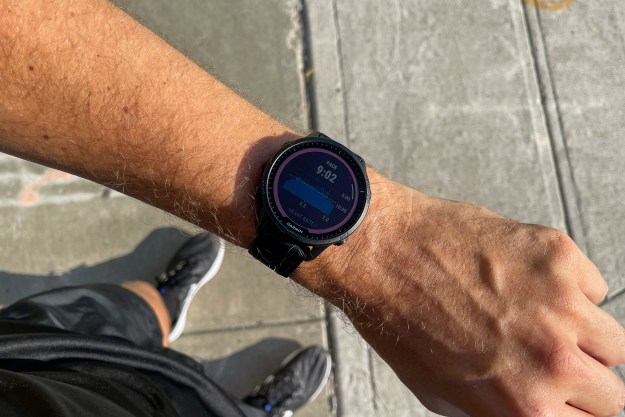
Lately, however, the topic has became a much bigger issue as science fiction has become science reality. The likes of Elon Musk of Tesla and Mustafa Suleyman of Google have written to the United Nations urging a ban on the development and use of autonomous “killer robots” such as drones, tanks, and machine guns.
But while the pace of this “third revolution in warfare” is speeding up, interest in similar weapons dates back years. Here are nine important milestones that set us on the path to where we are here in 2017.
Da Vinci’s Robotic Knight

If you’re looking for the point in history at which the idea of robotic troops on the battlefield became a possibility, you have to go all the way back to Italian Renaissance polymath Leonardo Da Vinci.
In the late 1400s, Da Vinci designed and built a robotic knight that was capable of sitting down, standing up, walking, and moving its head and arms. All of this was performed via a series of gears and pulleys.
The designs for this bot were rediscovered in sketchbooks during the 1950s, and roboticist Mark Rosheim used them to build a working prototype in 2002.
The first Tesla electric vehicle

In 1898, inventor Nikola Tesla showed off the world’s first wireless remote control vehicle (a small boat) at New York’s Madison Square Garden. Tesla’s demonstration involved maneuvering the boat without touching it, as well as it turning on-board lights off and on.
Later, he unsuccessfully attempted to sell the “teleautomaton” device, alongside a proposal for similarly radio-guided torpedoes, to the United States military. Tesla had big plans for the technology.
According to Margaret Cheney’s biography Tesla: A Man Out of Time, he described the device as not just a wireless torpedo but the, “first of a race of robots, mechanical men which will do the laborious work of the human race.”
Russian Teletanks

When you think about robot-controlled tanks being deployed in a wartime scenario, you probably picture something from the year 2040, not the year 1940 — but that’s exactly when the Soviet Union was using its “Teletanks.”
Made up of existing T-26 light tanks, kitted out with hydraulics and control, the unmanned Teletanks could be piloted from more than a kilometer away. Operators were able to remotely steer the vehicles, fire their machine guns, and even deploy a flame thrower. While they didn’t have any autonomous sensing capabilities, or even the ability to relay audio back to their operators, Teletanks were one of the earliest examples of warfare robots in action.
Until they got out of radio range and shuddered to a halt, that is!
Here comes Goliath
Okay, so starting a list entry with “the Nazis were ahead of their time with some of their ideas” doesn’t sound great. But how else to describe their invention of remote controlled robot, Goliath?
A mobile landline that was used by the Third Reich during World War II, Goliath was controlled using a wire — theoretically making it more reliable in military scenarios. Moving rapidly on two tracks, the device could be steered into the path of oncoming vehicles to blow them up.
It certainly isn’t impressive by today’s standards, but at the time, Goliath was an impressive early use of robots in a war zone. Both electric and gasoline versions were made, with a production run of more than 7,000 manufactured. For obvious reasons, not many of these are still around today.
The arrival of semi-autonomous guns

Today, autonomous guns for shooting down aircraft, drones and other unauthorized objects is something a number of groups are actively exploring. It was also a subject that cybernetics creator Norbert Wiener worked on during World War II.
Fascinated by the idea that the receiving and processing of information might trigger the creation of intelligent behavior, Wiener works with colleague Julian Bigelow on a project designed to improve the accuracy of anti-aircraft guns.
To achieve this, they develop technology which can automatically correct a gunner’s aim by predicting where his target is going to be next, and adjusting the sights accordingly.
Smarter weapons

In the late 1950s, seeking new and unorthodox weaponry to use in the Vietnam War, the U.S. Air Force introduced the use of laser-guided weapons and autonomous unmanned surveillance aircraft, designed to shoot film until they ran out of fuel.
These machines still required human intervention in deciding which targets to attack, but the use of tools such as “smart bombs” prefigured the modern usage of drone attacks in war zones.
Send in the drones

One month after 9/11, the United States demonstrated that robots can indeed be used as lethal weapons by launching the world’s first deadly airstrike from an MQ-1 Predator drone.
Now on display at the National Air and Space Museum in Washington, this Predator drone was the earliest example of a military tool that has been heavily used by the U.S. since then. Today, the most widely deployed military drones in the world are the Predator and larger Reaper drone.
Robot ground troops

Alongside the use of aerial drones, the conflict in Afghanistan also ushered in the rise of ground-based robots — such as the tank-like PackBots, used to search caves for targets and booby traps. Many of these robots were developed by an MIT spinoff called iRobot, best known for building the Roomba floor-cleaning robot.
From around 150 robots in 2004, the number of ground-based robots grew to 12,000 just four years later. According to a recent report, the U.S. military will have more robots on the battlefield than humans by 2025. It already has more drone operators than traditional pilots.
Other ground-based robot projects include the likes of the Energetically Autonomous Tactical Robot (EATR) — a bot able to power itself by eating organic matter, which fortunately turns out to be vegetarian.
The AI revolution

In the past several years, big breakthroughs in artificial intelligence (AI) have led to a number of military-related robotics projects. These have included the likes of US Mechatronics’ automated sentry gun, as well a machine called MIDARS: a four-wheeled robot equipped with cameras, radar, and weaponry able to patrol sites.
What makes many of these projects different is that, rather than simply being remote controlled by human operators, a growing number are capable of acting on their own. For the first time, the label of “autonomous weapon” is starting to live up to its billing.
Whether that turns out to be a good or bad thing remains to be seen. Either way, it’s going to transform the future of warfare.


